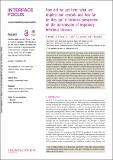How did we get here: what are droplets and aerosols and how far do they go? A historical perspective on the transmission of respiratory infectious diseases
Author(s)
Randall, K; Ewing, ET; Marr, LC; Jimenez, JL; Bourouiba, L
DownloadPublished version (671.3Kb)
Publisher with Creative Commons License
Publisher with Creative Commons License
Creative Commons Attribution
Terms of use
Metadata
Show full item recordAbstract
<jats:p>The COVID-19 pandemic has exposed major gaps in our understanding of the transmission of viruses through the air. These gaps slowed recognition of airborne transmission of the disease, contributed to muddled public health policies and impeded clear messaging on how best to slow transmission of COVID-19. In particular, current recommendations have been based on four tenets: (i) respiratory disease transmission routes can be viewed mostly in a binary manner of ‘droplets’ versus ‘aerosols’; (ii) this dichotomy depends on droplet size alone; (iii) the cut-off size between these routes of transmission is 5 µm; and (iv) there is a dichotomy in the distance at which transmission by each route is relevant. Yet, a relationship between these assertions is not supported by current scientific knowledge. Here, we revisit the historical foundation of these notions, and how they became entangled from the 1800s to today, with a complex interplay among various fields of science and medicine. This journey into the past highlights potential solutions for better collaboration and integration of scientific results into practice for building a more resilient society with more sound, far-sighted and effective public health policies.</jats:p>
Date issued
2021Department
Massachusetts Institute of Technology. Department of Civil and Environmental EngineeringJournal
Interface Focus
Publisher
The Royal Society
Citation
Randall, K, Ewing, ET, Marr, LC, Jimenez, JL and Bourouiba, L. 2021. "How did we get here: what are droplets and aerosols and how far do they go? A historical perspective on the transmission of respiratory infectious diseases." Interface Focus, 11 (6).
Version: Final published version